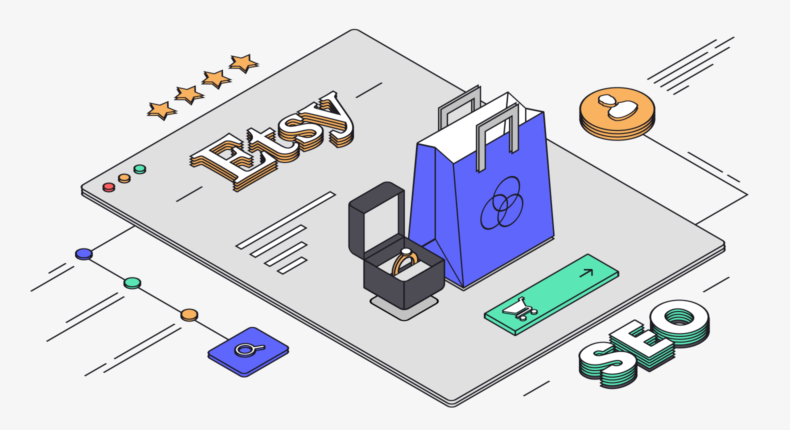Table of Contents
The number of buyers on Etsy.com nearly doubled between 2019 and 2020 – up to 81.6 million. As one of the largest ecommerce platforms available today, Etsy provides business owners a user-friendly way to expand their online presence to an engaged and growing audience of buyers, both on desktop and especially mobile, where sales are expected to continue rising. From 2013 to 2020, the share of Etsy’s mobile-generated sales rose from 30% to 61%.
So what is the best way to take advantage of this opportunity? Simple: A reliable and popular marketing strategy called Etsy SEO.
What is Etsy SEO?
Etsy SEO (search engine optimization) refers to the process of improving your Etsy store so that it appears higher in search results on the Etsy platform. This exposes your product listings to more potential buyers, giving you more opportunities to generate sales.
Not only does this approach make it easier for customers to find your products, but it also helps you create an organized storefront that is easier to manage.
While 89% of small businesses believe SEO is an effective marketing tool, only 2% say they actually use it as part of their strategy.
Given that poor marketing accounts for at least 14% of all startup failures, shop owners can greatly benefit from an Etsy SEO strategy.
Etsy SEO ranking factors
When someone types specific keywords into the search bar, the Etsy algorithm will analyze the corresponding categories for product tags, descriptions, and titles that match the search query. This step in the process is called query matching.
Once it has identified relevant listings, Etsy’s search algorithm will then rank them according to a number of factors, including:
- Recency: If the product was recently listed or relisted, it will receive a higher score.
- Listing Quality Score: Every time the listing is bought, liked, or shared after being viewed in the search engine results, this score increases.
- Relevancy Score: This score is a combination of how well the product matches the exact phrase that a buyer uses, which attributes are attached to the product, and whether the product title and tags also match.
- Market Experience Score: Etsy seller history is factored into overall ranking. Information like customer reviews, copyright issues, the shop’s policies, and “About Me” section make up this metric.
- Store Location: If the store is located in the same region as the user, it will take priority over other listings. This is because Etsy shoppers prefer lower shipping prices and they want to read articles written or translated into their primary language.
- Context-Specific Ranking: Just like Amazon or the Google search engine, consumer search behavior is used to provide ever-evolving results that best serve users.
Knowing more about how Etsy ranks listings, you can begin to configure your store.
Etsy SEO tips
While there are many SEO techniques you can follow to drive online traffic, not all of them are equally as successful on Etsy.
Consider the following tips as an Etsy SEO guide that you can reference to increase your customer base and boost sales.
Be clear, not cute
To rank for relevant keywords, you need to use them in your product listings. Rather than focusing on clever product names, see how you can incorporate important search terms into them. Customers should be able to tell right away whether you have what they want.
For example, here are the top 8 Etsy listings for “gold hoop earrings:”
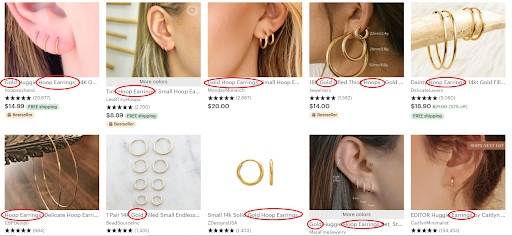
Notice (circled in red) how each item title contains some variation of those terms.
You should take the same approach with your shop name as well. By incorporating some of the focus keywords of your product line in the shop title and name, you will boost your relevancy score and earn higher rankings.
Take the number 1 and 2 listings for the “gold hoop earrings” search:

 The shop owners included “hoops” in their Etsy shop names and used “hoop” in their shop title (the description below the name), as well.
The shop owners included “hoops” in their Etsy shop names and used “hoop” in their shop title (the description below the name), as well.
When creating your shop sections, you should figure out how potential customers might like to filter and sort your listings. This could be by product type, color, material, size, language, etc.
Breaking up your Etsy shop into sections makes the shopping experience more user-friendly and accessible. Plus, if you can use keywords in your section categories, you’ll be sure to see a boost in your relevancy and marketing experience scores.
Use high-quality media
The product photos you use are the number 1 factor that influences purchases on Etsy:
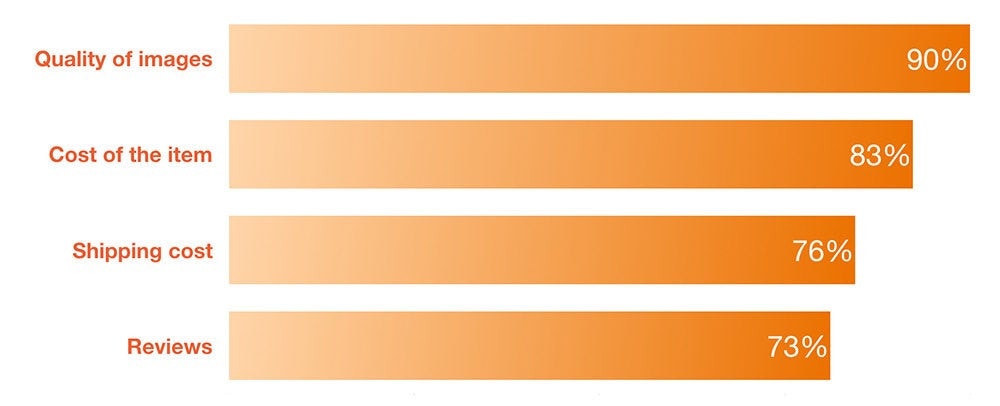
You can upload a maximum of ten photos per product listing, so it’s important that you choose ones that improve your conversion rate.
Optimized images should be high-resolution and include important product information as well. Adding text to the images (sizes/measurements, specifications, etc.) will also help customers better understand your offerings.
According to Etsy, there are 7 types of product photos that you should include on every listing:
- Scale shot: Demonstrates product size
- Studio shot: Shows product against a plain background
- Process shot: Gives a look at how the product is made
- Detail shot: Shows close-up product features and details
- Lifestyle shot: Includes the product in use
- Group shot: Combines multiple store products together
- Packing shot: Displays the packing process
Overall, you should use images to answer any questions a customer may have about how your product looks and functions, as well as, how it’s made and packaged.
Do Etsy keyword research
Just as you would for Google or YouTube, you need to research what your target market is searching for on Etsy. This first requires that you understand which customers you want to attract and how they might look for your products.
You can start by entering search terms yourself and getting a general sense of what ranks highly. To step up your keyword research, though, there are several SEO tools you can use:
eRank: This Etsy keyword researcher finds popular search terms and cross-references them with Google terms in order to find the best options. It comes in both a free standard version and a paid pro version.

Google Keyword Planner: A research tool that helps you identify the best keywords for your industry and niche. You can view search volumes and bid estimates for various terms.

Etsy Keyword Tool Dominator: An Etsy-specific research tool that targets long-tail keywords which have less competition and are easier to rank for.
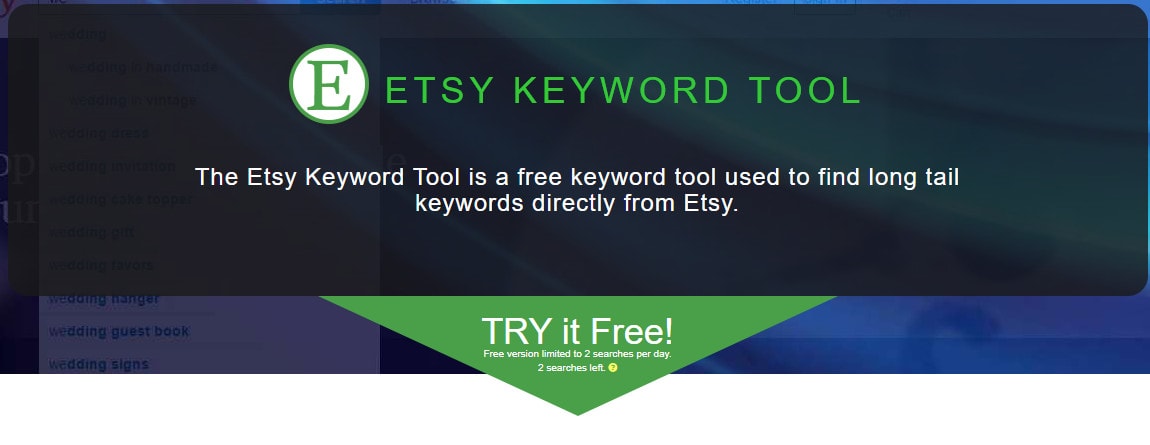
Marmalead: A subscription-based Etsy keyword brainstorming and store analysis tool. It can tell you how your shop compares to others in your niche and gives you information on how to improve your SEO.
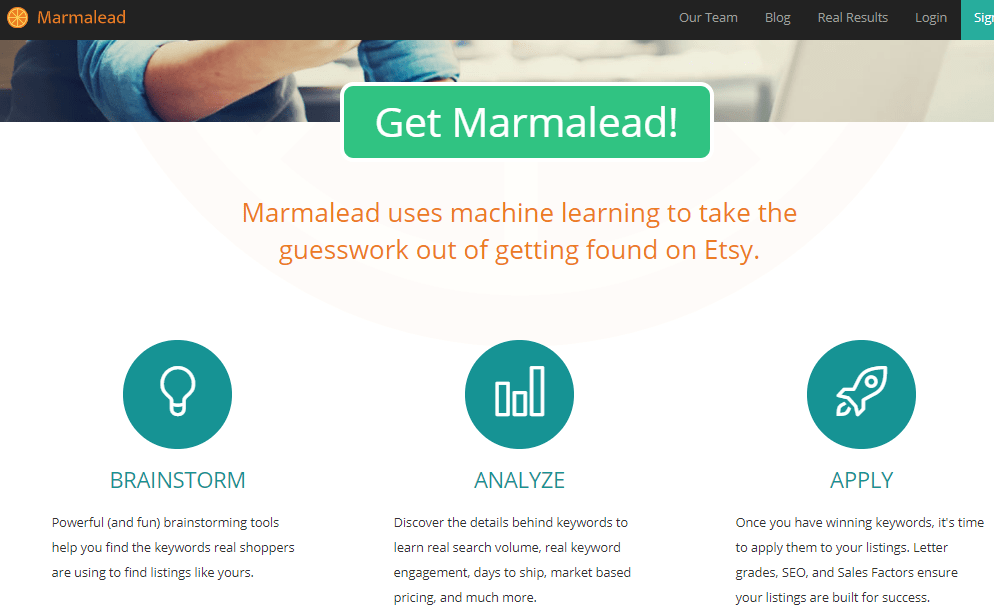
Make your store structure easy to understand
Ecommerce stores must provide top-notch user experiences in order to make up for the missing experience of shopping in-store. Because customers won’t be able to immediately access help navigating your “aisles,” you need to design your store in an effective way.
Customers should be able to find similar products via the categories sidebar:

The product images and descriptions should look uniform and polished. They should also provide tangible details like textures, smells, and material quality – all things that people would be able to investigate in a store.
Most importantly, they should make sense in the context of the site. Users should be able to find the products they’re looking for easily with the help of a logically organized menu with defined categories.
By offering the most professional and comprehensive product listings possible, as well as, organizing your site in a simple way, you will see improved user experience, leading to higher rankings and sales.
Include all valuable product details
Although it won’t be used to rank your listings, the product description is part of building an all-around fantastic listing. The product description is your chance to convince shoppers to buy your goods, so it should be thorough.
Consider including the following details in your description:
- Size and color options
- Product uses
- Manufacturing or crafting information
- Whether the items are sold individually or in sets/pairs
- Material options
- Customization availability
- Production time
- Shipping information
- Return policy
- Special business details (woman or minority-owned, sustainable, etc.)
Here is an excellent example from shop Weekend in LA Jewelry:

When you write the description, make sure you use formatting styles like bold, italics, underlining, bulleted/hyphenated lists in order to make them easy to read.
Tag your content as much as you can
The Etsy platform allows you to tag your products so that they appear in certain categories. You can add up to 13 of these tags in your item descriptions, and you should use all of them if you can.
Etsy tags can be up to 20 characters long, cannot be repeated, and can only use the trademark and copyright symbols as special characters.
The tags will typically show up at the bottom of the product page, where customers can view related products/categories based on the tags you choose:

They also help the algorithm decide which products in your store are related:
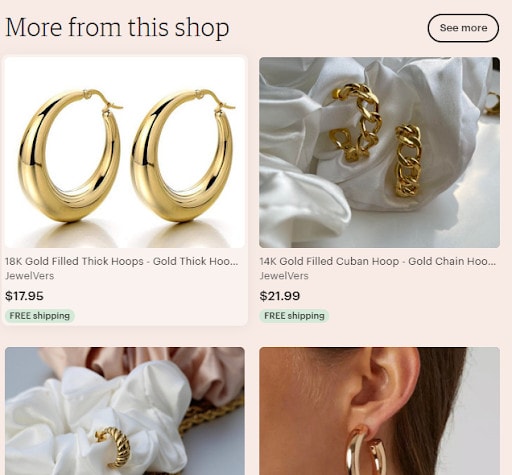
Overall, the use of Etsy tags improves your SEO visibility on the platform. This can increase your customer engagement and ultimately lead to more sales.
Keep your listings fresh
Remember that recency impacts your Etsy search rankings. Keep your listings fresh by:
- Revisiting poor-performing products and changing their listing titles
- Adding new listings or updating old ones
- Posting store announcements
- Offering special listings during the holiday season
- Renewing listings, especially for competitive keywords
Consistently updating, renewing, and reconfiguring your product pages can show visitors you are committed to maintaining the most up-to-date and relevant content.
Generate backlinks
When other websites post a link to your store, this is called a “backlink.” The more backlinks you earn from quality sources, the more credible and high-quality your shop will seem to the algorithm.
Creating social media accounts on platforms like Facebook, Instagram, and Pinterest is an excellent way to generate backlinks to your Etsy store.
The previous Etsy search for “gold hoop earrings” displays more than 300,000 results. When you look at the top listing, however, you will find that the store has accounts on other platforms. Here’s their Instagram account:

And here’s their Pinterest:

Social accounts can help with product promotion, which can result in backlinks from fans and followers. Partnering with other brands for cross-promotion and product releases or sponsored content are great ways to use social media to generate backlinks.
You can also create a blog that’s connected to your store. Bloggers use written content to drive traffic to their ecommerce sites all the time. As people come looking for information on a topic, you can provide them with a solution in the form of your product.
Both of these are easy avenues for generating backlinks and building your industry credibility. When you implement these strategies, your rankings will increase which will bring more customers to your store.
Get a complimentary SEO audit
Online sales generate more than 4 trillion dollars in annual revenue, and Etsy is one of the top platforms to tap into this growing ecommerce opportunity. By implementing Etsy SEO techniques, you can improve your shop’s visibility and reach more customers – all without having to spend money on ad campaigns.
Want to see how you’re doing with SEO? Get an instant SEO audit below. Or, schedule a free consultation to see how intent SEO can boost search traffic revenue by 700%.
